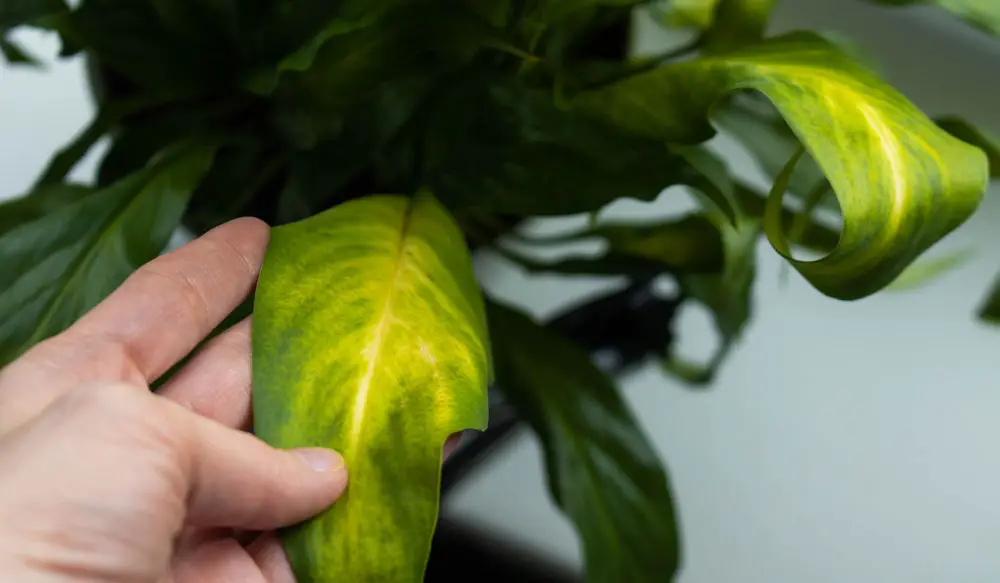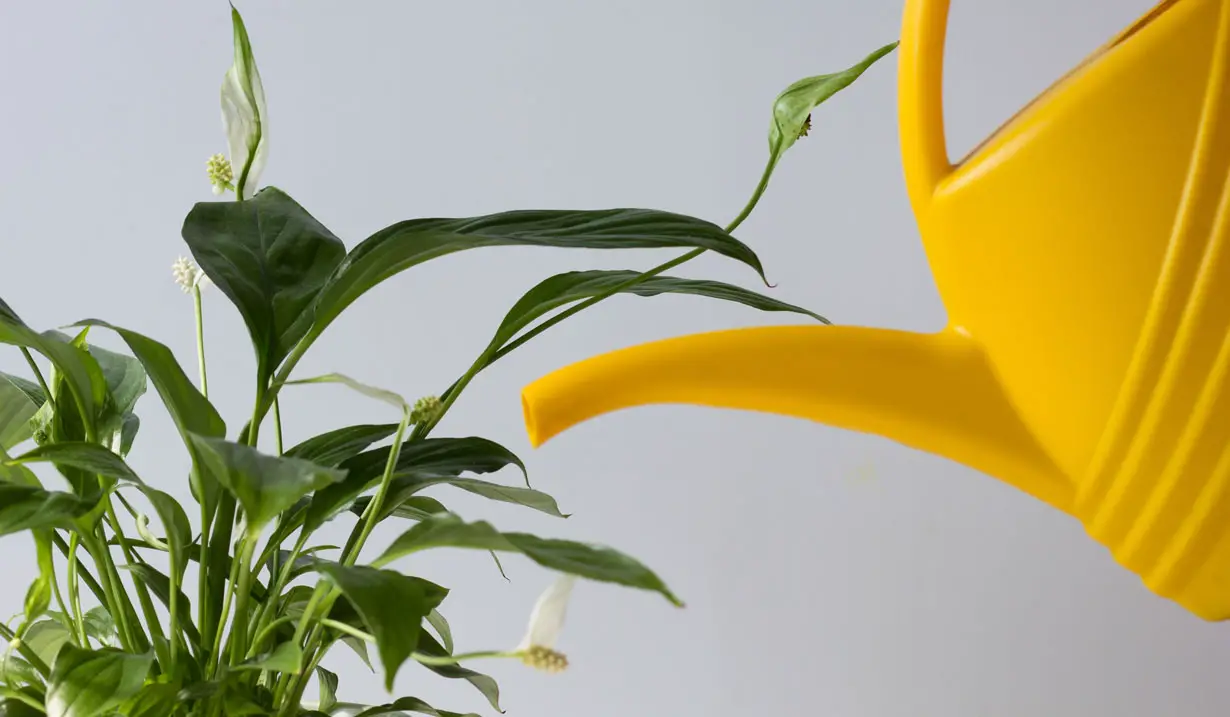How Long Do Peace Lilies Live?

This post follows our research editorial guidelines.

Don’t we all want peace everlasting? Play your cards right, and your Peace Lily (Spathipyllum) will live well beyond what’s expected. While it’s generally assumed these stunning plants only live around five years at most, with diligence and proper care you can enjoy their glossy leaves and elegant blooms for considerably longer!

Table of Contents
How Long Do Peace Lilies Last?
Peace lilies typically live between three to five years; however, with good consistent care the peace lily can flower and thrive for decades.
“For a little history, the Peace Lily is not really a lily; it was just similar to the white lily. Peace Lilies are often associated with peace, purity and innocence. But some in the new age movement say they harmonize conflicts and help with negativity. Despite what one may say they do, we all know they are pleasing to the eye and bring beauty to any room.” Novella Springer, Calaveras Master Gardener at the University of California.
Why grow a peace lily?
The humble peace lily has a lot going for it. They’re an enduring classic, and for good reason.
Peace lilies thrive in darker rooms than most indoor plants, providing a pop of sophisticated greenery in just about any corner of your home or office. It’s also one of the few indoor plants that flower regularly, producing elegant white blossoms known as spathes that last for months at a time.
Probably the most surprising reason to grow a peace lily is that they have the ability to scrub the air around it of hazardous chemicals. Studies by NASA conducted as part of their clear air research programs found that peace lilies are among the best indoor plants at removing atmospheric pollutants.
How to care for Peace Lilies
How to Water a Peace Lilies
Watering a peace lily is probably the trickiest part of their care, but it becomes second nature once you have the hang of it.
To water your peace lily, you’ll need to first make sure you’re giving them the right water. They’re chemically sensitive, and can’t handle hard water, softened water, cold water or tap water that contains chlorine or fluoride. Divas indeed!
Some folks harvest rainwater for their plants, but honestly that’s a lot of fuss. I prefer a cartridge style filter jug left out until the water is warm. That removes everything a lily might pitch a fit over, and it’s already in what amounts to a very fancy watering can. Distilled water is also fine.
Once you have that under control, it’s just a matter of watering when the top inch or so of soil is totally dry to the touch. I go into more detail on how to water a peace lily here, but honestly so long as you use clean water, and not too much you’ll do just fine.

Best Soil for Peace Lilies
Peace lilies prefer a potting blend that drains well but that contains lots of organic material. Most good quality commercial blends will get the job done, but I like to mix through one part vermiculite to three parts of potting soil to make sure it drains well. Vermiculite is a mineral that holds onto moisture while letting the excess drain freely, a fantastic trait to add to a peace lily’s mix.
They don’t need to be re-potted that often, no more than once every other year at the beginning of spring. That will give the lily a good foundation for the season’s new growth.
Best Light for Peace Lilies
Your peace lily will manage just fine in low light, but does best in moderate to bright light. A southern or southeastern facing room is perfect. The more light they have the more chance you have of a rich display of blooms, as they don’t flower as readily in the shadows.
That said, don’t be tempted to plop them in direct sun. Their dark glossy leaves are very vulnerable to sunburn, and will quickly crisp up if struck by an errant sunbeam.
Best Temperature for Peace Lilies
Peace lilies love consistently warm temperatures, with little variation. Ideally you’d keep them between 68 and 85°F(20 to 30°C). They can be quite badly damaged by low temperatures, even those above freezing, so err on the side of caution and keep them away from drafts, air conditioning vents and out of unfinished basements and lofts. That will add years to their life all on its own.
Best Humidity Level for Peace Lilies
It’s an often overlooked part of plant care, but humidity levels around your peace lily make a surprising amount of difference to their lifespan. Peace lilies are rain-forest plants and thrive in high humidity environments. While they dry air in homes and offices won’t kill your lily, it will lead to crisp brown leaf tips and a shortening of that otherwise astonishing lifespan.
You can counter these deleterious impacts on your peace lily by providing it with some extra moisture it the air around it. Misting helps, but a humidifier is better. If you’d rather something more passive, moving your lily to a humid bathroom of kitchen is another option.
How to Fertilize Peace Lilies
As mentioned above, peace lilies are chemically sensitive, so fertilizing them can be something of a delicate art. It’s very easy indeed to burn their delicate roots with an overly enthusiastic dosing of plant food.
Apply fertilizer gently and infrequently, only during the spring and the summer. I’m a fan of adding a half strength dose of good quality balanced liquid fertilizer to my lily’s watering regime, no more than once a month through the growing season.
4 Peace Lily Problems to Watch for

Over-watering
The eternal specter of over-watering rears its ugly head once more, a particular hazard to peace lilies. The delicate roots of the peace lily rot readily if left in standing water, or if the water is too cold, or there’s too much of it at the wrong time of year.
Keep an eye out for:
- Drooping leaves that do not respond to watering
- Soft brown stems and leaves
- Infestations of fungus gnats
- Mold or mildew on the surface of the potting soil
If caught early, you can remedy over-watering by allowing your peace lily to dry out. But more often than not by the time you notice something is awry, you’ve got rotting roots in that stale soil and you’ll need to repot. Clear away old soil, trim away dead roots and be sure to use a clean pot and fresh medium.
Chemical Burns
Chemical burns are a tough one to spot in peace lilies. It shows first as brown tips on the leaves, a common symptom that also develops in low humidity environments or to plants that are often left to dry out a little too long.
It’s caused by a buildup of harmful chemicals in the soil, often excess fertilizer or minerals from tap water. No matter what the cause, you’ll need to flush the soil with lots of clean water to get rid of the toxins.
It’s easier than it sounds – just run as much clean water into the pot and out the drainage holes. Done in two five minute bursts with a rest period between, this should clear the buildup and get your peace lily back in top shape.
No Peace Lily Flowers
Peace lilies are one of the few plants that flower reliably indoors, but sometimes even the most reliable of blossoms fails to materialize.
I write more extensively on peace lily flowers here, but in general you can blame an absence of blossoms on low light. A lily needs to really be able to bask in the sunshine in order to have the energy to produce those elegant spathes.
The other two causes are somewhat beyond the control of most gardeners. Peace lilies will only flower after about a year of age, so if yours is a youngster it’s just a matter of waiting. Likewise, many cultivars will only bloom in the spring. In both cases the only cure is patience!
Common pests
Lilies are largely pest free, but even these stalwart superstars take a hit every now and then. Keep an eye out for these most common pests.
Mealy bugs
Mealy bugs are a group of fluffy little monstrosities that like to suck the sap from your peace lily. They cluster in groups around veins and in the folds found at the base of the leaves. They look a bit like little puffs of cotton candy or wool.
Spider mites
So small as to be invisible, spider mites also suck sap. They’re tiny, smaller than a sesame seed, and they spin a fine silk over the surface of their victim.
Fungus Gnats
These little flies love overly wet potting mix. Fungus gnats lay their eggs in the soil, and the resulting grub will mostly eat decaying organic matter.
If you want to treat them, natural remedies like neem oil or horticultural soap are best for indoor plants. Its easier on the plant and safer for the other people that share the space. If caught early you can also just wipe them off with a cotton bud dipped in rubbing alcohol.
Pruning Peace Lilies

A peace lily’s lovely blossoms last a month or two – an astonishing feat. But even their time comes, and the dead flower will need to be removed. Likewise, once the older leaves have reached the end of their lifespan they’ll need to be trimmed away.
The best way to do this is to cut them neatly from the plant with a pair of clean gardening shears, perhaps an inch clear of the soil. You can safely compost the discarded flower or leaf.
How Often to Water a Peace Lily
How often to water a peace lily will come down to a few factors, mostly the temperature and the time of year.
A hot, sunny day will result in the peace lily using more of its water reserves for various biological functions, and the soil itself will dry out faster too. In contrast, peace lilies often slip into a state of near dormancy over winter, sleeping away the cold days and using very little water.
In general I recommend you water your peace lily only when the top inch or two of soil is dry. In summer you may need to water once a week or so, and in winter it may be upwards of a month. Your lily will signal if it needs more by drooping quite dramatically.
Final Thoughts
Getting a peace lily to live for decades is an endurance event. You’ll need to keep its watering in check and provide it with good light and a new pot of soil every other year. But who knows? Keep up the good work and you could have an elegant peace lily bringing a touch of sophistication to your home for decades to come.
